This is the second of my two-part diary of the fossils from the Chuckanut Formation (C/F), located near Bellingham in Northwestern Washington State. As noted in part 1, (flora), this formation developed during the Eocene Epoch, some 50 million years ago (ma). This area was a subtropical fluvial plain on to which sediments were deposited and ultimately hardened into sandstone, shale, and siltstone that captured specimens of both flora and fauna of that time. (No new pseudofossils in this part.)
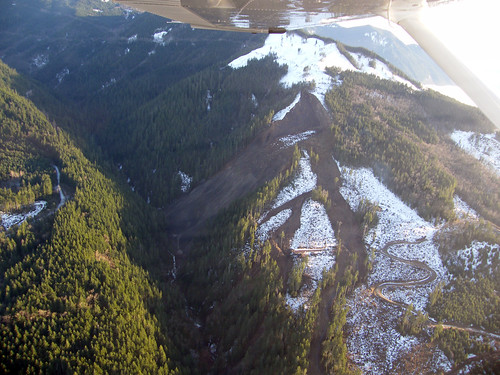
Racehorse Creek land slide and fossil beds
There have been two primary sites from which fossils have been found in the C/F. One is on and around Chuckanut mountain, including Chuckanut and Bellingham bays, as well as Bellingham itself (see map in part 1).
A second site is about 20 miles east of Bellingham in the foothills of the Cascade Mountains, toward Mt. Baker. This site is like a gift that keeps on giving in that it is on a shale and sandstone hill above Racehorse Creek that continues to cleave itself off with landslides, each one freeing another set of 50 million year old fossils. (See photo above of the slides)
Like the flora, fauna too was assumed to have been abundant in this subtropical delta flood plain but considerably fewer such fossils have been found relative to the plentiful flora. No skeletal fossils have been found yet, leaving paleontologists to rely largely on animal tracks left in the mud. Some of the tracks found are indistinct and thus difficult to positively identify. Others are more clearly identifiable or at least gave clues to their origin. Of those identifiable, a number include distant ancestors of our current species along with some that have become extinct altogether. Among the vertebrate tracts found were birds, reptiles, and mammals. For a time perspective, this Eocene Epoch occurred some 10 to 12 million years following the great dinosaur extinction, approximately 65 ma.
Birds:
The most spectacular finding in the Racehorse creek slide was the footprint of a Diatryma, a 7 to 8 foot tall, 380 lb., flightless bird â an original âBig Bird.â These tracks were identified by Western Washington University paleontologist, George Mustoe after a major landslide opened up a large hillside of sandstone in 2009.
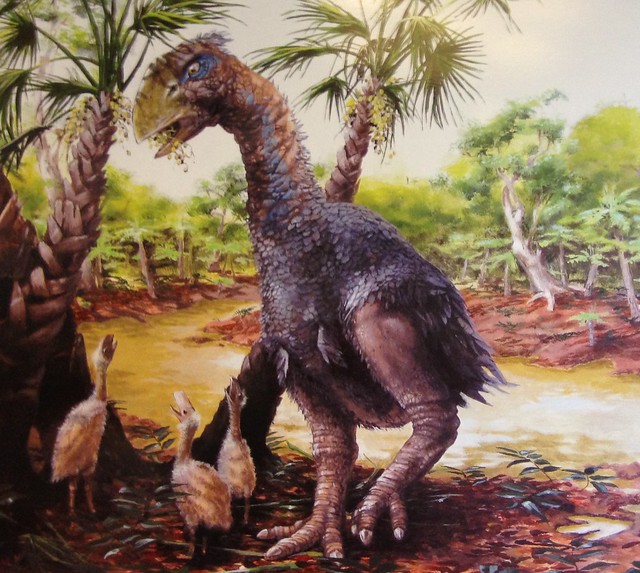
Artist’s conception of Diatryma, Marlin Peterson, 2011, WWU Geology Department Display.
Subsequently, 18 tracks from 15 slabs have been found in the shale and sandstone residue at the site. Although near complete skeletons of Diatryma have been found in Wyoming, New Mexico, and Europe, these are the first tracks ever found. Diatryma was once thought to be carnivorous predator due to the size and large beaks. However, the discovery of these tracks revealed that the bird had small, blunt claws rather than grasping talons characteristic of carnivorous birds, leading its discoverers to conclude that Diatryma was an herbivore.
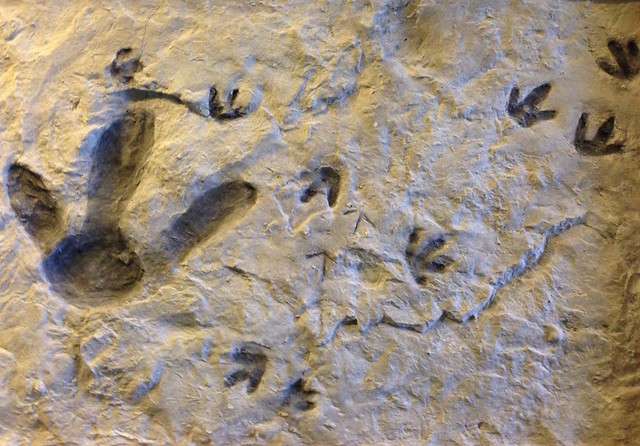
Diatryma tracts, note blunt toes
Concerning taxonomic identification:
Very similar fossil remains of the same age in Europe have been placed in the genus Gastornis. Reevaluation of the taxonomy may yet show that Diatryma may be congenetic with this other huge bird (Buffetaut, 1997). If that is the case, then the genus Gastornis will take precedence, as it was used first in taxonomic descriptions. In the meantime, âDiatrymaâ is usually used for the North American birds. In the early Eocene, North American and Europe were still connected by a polar land bridge through Greenland and Scandinavia, so the birds could have spread one way or the other; most specialists will agree that radiation was probably east to west.
Other birds tracks found in the same sandstone slab with the diatryma tracks include a heron and other shorebirds. Note in the above photo of the slab with the Diatryma track, other prints are clearly evident that include a heron and other shore birds. A mammal track is also evident and will be discussed below.
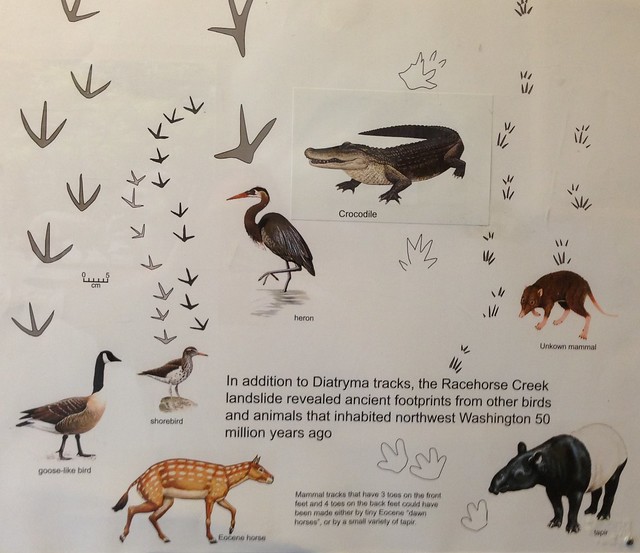
A multitude of faunal tracts were found in the same strata.
From WWU Geology Department display
Mammals:
Tracks from a small equid, called dawn horse, or Eohippus believed to be the earliest horse, (Chyracotheryium), are also seen in the sandstone slab containing Diatryma tracks. Obviously they coexisted and commingled. In the depiction above, the Eohippus is the small, dog-sized, deer-like animal with the spotted buff colored coat. The Eohippus had hoofs with four toes on front feet and three toes on its hind feet.

Eohippus tracts (note front feet have four toes and back has three)
The “Dawn Horse” is thought to be an extinct ancestor of horses that flourished in North America and Europe during the Eocene. Even though these animals are more commonly known as Eohippus they are now properly placed in the genus Hyracotherium,
Additional Mammal tracks found at the Racehorse Creek site included what appeared to have been a herd of hippopotamus-like animals with blunt feet. Although the tracts are not discrete enough to positively identify, they are thought to be of the Orders Pantodonta or Dinocerata (blunt foot herbivores).
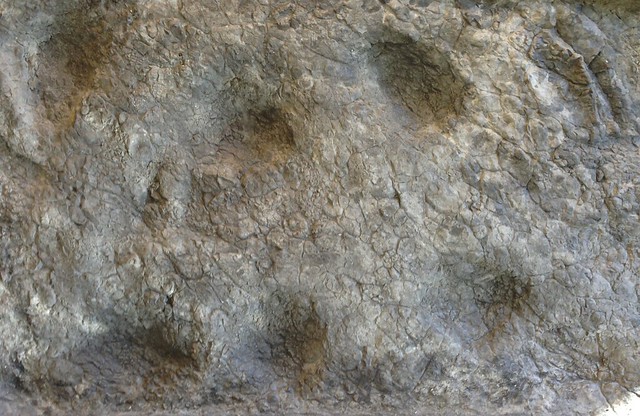
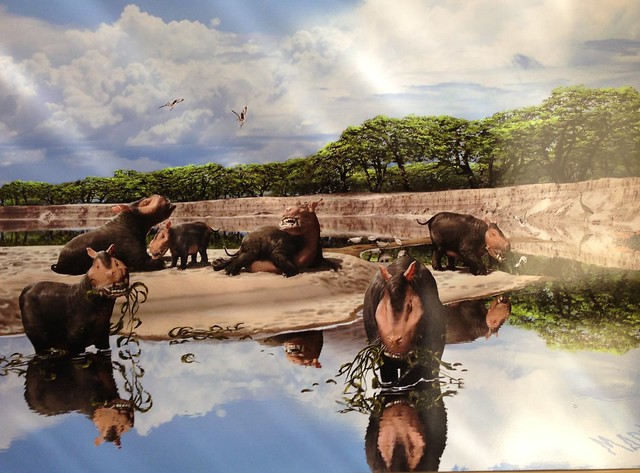
Artist’s depiction of Pantodonta or Dinocerata
Tapirs were widely spread during this Epoch and their prints too were found in the C/F as were Creodonts, a dominant predatory carnivore of the Eocene. Both the tapir and the Creodont are depicted in the mural below by Marlin Peterson, displayed in the Geology Department at Western Washington University.
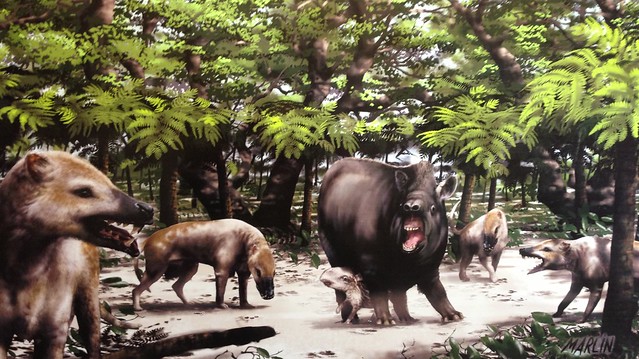
Creodonts depicted as preying on Tapir and infant
Reptiles:
Vestiges of two reptiles have also been found in the Chuckanut Formation. One was a turtle fossil specimen belonging to the Trionychidae family of soft shelled turtles.
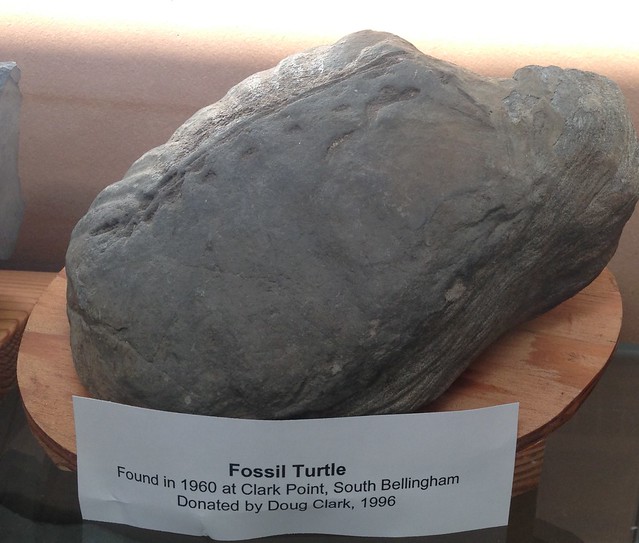
Crocodile tracks are also found in the C/F. Crocodiles were known to be widely distributed in the subtropical climes of the Eocene much as they are today.
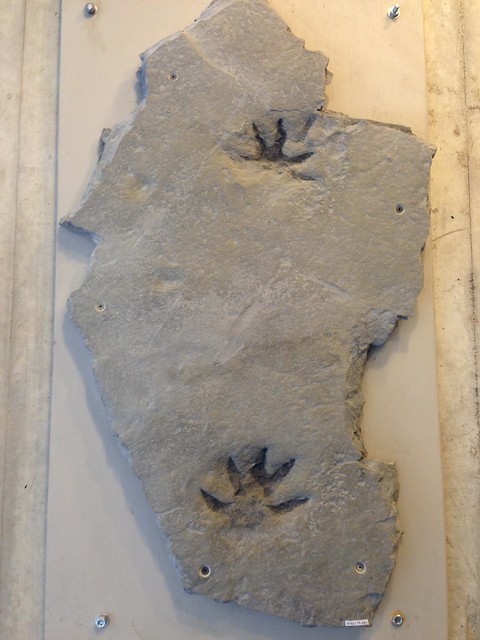
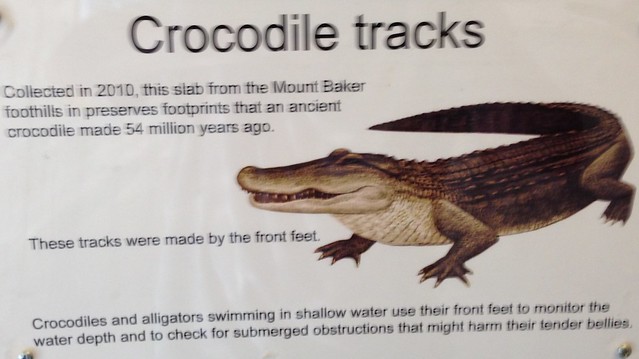
Among the additional animal life found in this productive formation are bivalves such as fresh water mussels (Anodonta) and the river snail (Viviparus). Insect signs too have been found including unidentified insect wings and plants that show evidence of leaf damage by butterflies, moths, and leaf miners.
With each new rainy season, the Chuckanut Formation, Racehorse Creek sites reveal more species of both flora and fauna of the Eocene from Northwest Washington. The prediction for our area with climate change is for more precipitation. If so, I guess we will continue to uncover more of our ancestors from our 50 million year old Eocene past.
5 comments